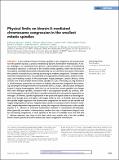Physical limits on kinesin-5-mediated chromosome congression in the smallest mitotic spindles
Author(s)
McCoy, K. M.; Tubman, E. S.; Tank, D.; Clancy, S. A.; O'Toole, E. T.; Berman, J.; Odde, D. J.; Claas, Allison Mary; ... Show more Show less
DownloadMcCoy-2015-Physical limits on k.pdf (2.223Mb)
PUBLISHER_CC
Publisher with Creative Commons License
Creative Commons Attribution
Terms of use
Metadata
Show full item recordAbstract
A characteristic feature of mitotic spindles is the congression of chromosomes near the spindle equator, a process mediated by dynamic kinetochore microtubules. A major challenge is to understand how precise, submicrometer-scale control of kinetochore microtubule dynamics is achieved in the smallest mitotic spindles, where the noisiness of microtubule assembly/disassembly will potentially act to overwhelm the spatial information that controls microtubule plus end–tip positioning to mediate congression. To better understand this fundamental limit, we conducted an integrated live fluorescence, electron microscopy, and modeling analysis of the polymorphic fungal pathogen Candida albicans, which contains one of the smallest known mitotic spindles (<1 μm). Previously, ScCin8p (kinesin-5 in Saccharomyces cerevisiae) was shown to mediate chromosome congression by promoting catastrophe of long kinetochore microtubules (kMTs). Using C. albicans yeast and hyphal kinesin-5 (Kip1p) heterozygotes (KIP1/kip1∆), we found that mutant spindles have longer kMTs than wild-type spindles, consistent with a less-organized spindle. By contrast, kinesin-8 heterozygous mutant (KIP3/kip3∆) spindles exhibited the same spindle organization as wild type. Of interest, spindle organization in the yeast and hyphal states was indistinguishable, even though yeast and hyphal cell lengths differ by two- to fivefold, demonstrating that spindle length regulation and chromosome congression are intrinsic to the spindle and largely independent of cell size. Together these results are consistent with a kinesin-5–mediated, length-dependent depolymerase activity that organizes chromosomes at the spindle equator in C. albicans to overcome fundamental noisiness in microtubule self-assembly. More generally, we define a dimensionless number that sets a fundamental physical limit for maintaining congression in small spindles in the face of assembly noise and find that C. albicans operates very close to this limit, which may explain why it has the smallest known mitotic spindle that still manifests the classic congression architecture.
Date issued
2015-09Department
Massachusetts Institute of Technology. Department of Biological EngineeringJournal
Molecular Biology of the Cell
Publisher
American Society for Cell Biology
Citation
McCoy, K. M., E. S. Tubman, A. Claas, D. Tank, S. A. Clancy, E. T. O’Toole, J. Berman, and D. J. Odde. “Physical Limits on Kinesin-5-Mediated Chromosome Congression in the Smallest Mitotic Spindles.” Molecular Biology of the Cell 26, no. 22 (September 9, 2015): 3999–4014.
Version: Final published version
ISSN
1059-1524
1939-4586